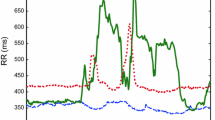Abstract
In this paper, a method for apnea bradycardia detection in preterm infants is presented based on coupled hidden semi Markov model (CHSMM). CHSMM is a generalization of hidden Markov models (HMM) used for modeling mutual interactions among different observations of a stochastic process through using finite number of hidden states with corresponding resting time. We introduce a new set of equations for CHSMM to be integrated in a detection algorithm. The detection algorithm was evaluated on a simulated data to detect a specific dynamic and on a clinical dataset of electrocardiogram signals collected from preterm infants for early detection of apnea bradycardia episodes. For simulated data, the proposed algorithm was able to detect the desired dynamic with sensitivity of 96.67% and specificity of 98.98%. Furthermore, the method detected the apnea bradycardia episodes with 94.87% sensitivity and 96.52% specificity with mean time delay of 0.73 s. The results show that the algorithm based on CHSMM is a robust tool for monitoring of preterm infants in detecting apnea bradycardia episodes.

Apnea Bradycardia detection using Coupled hidden semi Markov Model from electrocardiography. In this model, a sequence of hidden states is assigned to each observation based on the effects of previous states of all observations





Similar content being viewed by others
References
Zhao Jing, Gonzalez Fernando, Dezhi M u (2011) Apnea of prematurity: from cause to treatment. Eur J pediatr 170(9):1097–1105
Eichenwald EC et al (2016) Apnea of prematurity. Pediatrics, 137(1)
Mathews TJ, et al. (2013) Infant mortality statistics from the 2010 period linked birth/infant death data set
Janvier A, Khairy M, Kokkotis A, Cormier C, Messmer D, Barrington KJ (2004) Apnea is associated with neurodevelopmental impairment in very low birth weight infants. J Perinatol 24(12):763–768
Poets CF, Stebbens VA, Samuels MP, Southall DP (1993) The relationship between bradycardia, apnea, and hypoxemia in preterm infants. Pediatric Res 34(2):144–147
Portet F, Gao F, Hunter J, Sripada S (2007) Evaluation of on-line bradycardia boundary detectors from neonatal clinical data. In: Engineering in medicine and biology society, 2007. EMBS 2007. 29th annual international conference of the IEEE, IEEE, pp 3288–3291
Cruz J, Hernández A I, Wong S, Carrault G, Beuchee A (2006) Algorithm fusion for the early detection of apnea-bradycardia in preterm infants. In: Computers in cardiology, 2006, IEEE, pp 473–476
Dumont J, Hernández AI, Fleureau J, Carrault G (2008) Modelling temporal evolution of cardiac electrophysiological features using hidden semi-markov models. In: Engineering in medicine and biology society, 2008. EMBS 2008. 30th annual international conference of the IEEE, IEEE, pp 165–168
Altuve M, Carrault G, Beuchée A, Pladys P, Hernández AI (2014) Online apnea–bradycardia detection based on hidden semi-markov models. Medical & biomedical engineering & computing, pp 1–13
Masoudi S, Montazeri N, Shamsollahi MB, Ge D, Beuchee A, Pladys P, Hernandez AI (2013) Early detection of apnea-bradycardia episodes in preterm infants based on coupled hidden markov model. In: 2013 IEEE international symposium on Signal processing and information technology (ISSPIT), IEEE, pp 000243–000248
Rabiner L (1989) A tutorial on hidden markov models and selected applications in speech recognition. Proc IEEE 77(2):257– 286
Yu S-Z, Kobayashi H (2006) Practical implementation of an efficient forward-backward algorithm for an explicit-duration hidden markov model. IEEE Tran Signal Process 54(5):1947–1951
Ferguson JD (1980) Variable duration models for speech. In: Proc Symposium on the application of hidden markov models to text and speech, pp 143–179
Brand M, Oliver N, Pentland A (1997) Coupled hidden markov models for complex action recognition. In: 1997 IEEE computer society conference on Computer vision and pattern recognition, 1997. Proceedings, IEEE, pp 994–999
Brewer N, Liu N, De Vel O, Caelli T (2006) Using coupled hidden markov models to model suspect interactions in digital forensic analysis. In: International workshop on Integrating AI and data mining, 2006. AIDM’06, IEEE, pp 58–64
Ghahjaverestan NM, Masoudi S, Shamsollahi M, Beuchee A, Pladys P, Ge D, Hernandez A (2015) Coupled hidden markov model based method forapnea bradycardia detection. Accepted in IEEE Journal of Biomedical and Health Informatics. https://doi.org/10.1109/JBHI.2015.2405075
Natarajan P, Nevatia R (2007) Coupled hidden semi markov models for activity recognition. In: IEEE workshop on Motion and video computing, 2007. WMVC’07, IEEE, pp 10–10
Brand M Coupled hidden markov models for modeling interacting processes, 1997. Technical Report 405
Bradley AP (1997) The use of the area under the roc curve in the evaluation of machine learning algorithms. Pattern Recognition 30(7):1145–1159
Neath AA, Cavanaugh JE (2012) The bayesian information criterion:, background, derivation, and applications. Wiley Interdisciplinary Reviews: Computational Statistics 4(2):199–203
Rauch J, Smoller J (1978) Qualitative theory of the fitzhugh-nagumo equations. Adv Math 27(1):12–44
Pan J, Tompkins WJ (1985) A real-time QRS detection algorithm. IEEE Transactions on Biomedical Engineering (3): 230–236
Altuve M, Carrault G, Cruz J, Beuchée A, Pladys P, Hernandez A (2011) Multivariate ecg analysis for apnoea? bradycardia detection and characterisation in preterm infants. Int J Biomed Eng Technol 5(2):247–265
Haskova K, Javorka K, Javorka M, Matasova K, Zibolen M (2013) Apnea in preterm newborns: determinants, pathophysiology, effects on cardiovascular parameters and treatment. Acta Medica Martiniana 13(3):5–17
Poets CF (2010) Apnea of prematurity: what can observational studies tell us about pathophysiology. Sleep Med 11(7):701–707
Funding
This work has been supported by the Center for International Scientific Studies and Collaboration (CISSC) and by Egide-Gundishapour program.
Author information
Authors and Affiliations
Corresponding author
Additional information
Publisher’s note
Springer Nature remains neutral with regard to jurisdictional claims in published maps and institutional affiliations.
Electronic supplementary material
Rights and permissions
About this article
Cite this article
Montazeri Ghahjaverestan, N., Shamsollahi, M.B., Ge, D. et al. Apnea bradycardia detection based on new coupled hidden semi Markov model. Med Biol Eng Comput 59, 1–11 (2021). https://doi.org/10.1007/s11517-020-02277-8
Received:
Accepted:
Published:
Issue Date:
DOI: https://doi.org/10.1007/s11517-020-02277-8




